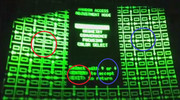|
|
Post by Decibel on Aug 20, 2015 8:50:08 GMT -5
You are right that there are some diodes on the smaller board where the newer board has resistors. The vallues on the smaller board ar 10 Ohm in my case so if you still have the diodes you will likely also have the 10 Ohm resistors. I think upgrading would solve the issue like the bulletin suggests. Replacing the diodes with 100 Ohm resistors too.
I have already replaced the 10 ohm resistors with those of 100 ohm. But not those where are diodes. I do not think we can replace the diodes with resistors because the circuits of the two boards are very similar but there are differences in some parts. I can upload both diagrams if necessary. |
|
|
|
Post by mastertech on Aug 20, 2015 9:18:53 GMT -5
It's funny. All these posts and my last question is still not answered.
|
|
|
|
Post by Decibel on Aug 20, 2015 9:22:00 GMT -5
What question?
|
|
|
|
Post by mastertech on Aug 20, 2015 9:30:15 GMT -5
Can you see the anomaly that you see in the grid, in the video image on screen?
|
|
|
|
Post by Decibel on Aug 20, 2015 9:42:00 GMT -5
I thought I had already answered this question: of course the images are distorted.
The grid lines are not stable but are flickering.
Removing the jumpers, the distorsions disappears, but I believe that removing would cause the failure of the convergence adjustments.
|
|
|
|
Post by mastertech on Aug 20, 2015 10:05:56 GMT -5
I thought I had already answered this question: of course the images are distorted. The grid lines are not stable but are flickering. Removing the jumpers, the distorsions disappears, but I believe that removing would cause the failure of the convergence adjustments. I know all of this. I know the grid lines are not stable. What I am asking is, if you "play actual video" (a movie or something) is "THAT" image stable? Or does the movie image jump around also? |
|
|
|
Post by Decibel on Aug 20, 2015 10:26:51 GMT -5
I hope I have understood your question. The images of a movie are stable. They do not jump. But flicker. I'll try to make a video clip.
|
|
|
|
Post by mastertech on Aug 20, 2015 11:26:40 GMT -5
I hope I have understood your question. The images of a movie are stable. They do not jump. But flicker. I'll try to make a video clip. Good. That will help. Video of the grid would be helpful also. |
|
|
|
Post by Decibel on Aug 20, 2015 12:11:57 GMT -5
Unfortunately Photobucket reduce the quality of the videoclip ( 50mb in .mpg ---> 4mb in .mp4) However the issue is visible.  |
|
|
|
Post by mastertech on Aug 20, 2015 17:32:49 GMT -5
So, if I am seeing this correctly, the problem is, on the left side of the image it appears like double lines and boxes and even the letters are doubled,(circled in red). And on the right side it is mostly normal, even the letters, (circled in blue). Is this correct?  |
|
|
|
Post by Decibel on Aug 21, 2015 0:40:28 GMT -5
Correct but I would say that on the right side the issue is minor but there is also.
|
|
Deleted
Deleted Member
Posts: 0
|
Post by Deleted on Aug 21, 2015 3:41:37 GMT -5
You are right that there are some diodes on the smaller board where the newer board has resistors. The vallues on the smaller board ar 10 Ohm in my case so if you still have the diodes you will likely also have the 10 Ohm resistors. I think upgrading would solve the issue like the bulletin suggests. Replacing the diodes with 100 Ohm resistors too.
I have already replaced the 10 ohm resistors with those of 100 ohm. But not those where are diodes. I do not think we can replace the diodes with resistors because the circuits of the two boards are very similar but there are differences in some parts. I can upload both diagrams if necessary. I am curious so please uload the diagram of the older board. |
|
|
|
Post by Decibel on Aug 21, 2015 3:49:35 GMT -5
|
|
Deleted
Deleted Member
Posts: 0
|
Post by Deleted on Aug 21, 2015 7:39:24 GMT -5
You are right. In the older one there are less mosfets around those resistors that had to be replaced. No easy way to make them the same.
|
|
|
|
Post by gjaky on Aug 21, 2015 7:55:06 GMT -5
The doubled mosfets on the output help in heat disspiation (at higher scanrates) in a cine9/cinemax this is a lesser issue, the general build up is the same for both versions. I see no big difference between the original and the suggested diode replacement, only just the case differs, however increasing those 10pF capacitors to 22pF and the 10R -> 100R will stabilize more the amplifier.
|
|